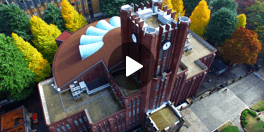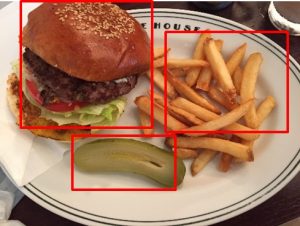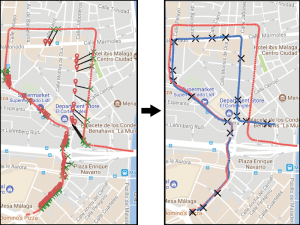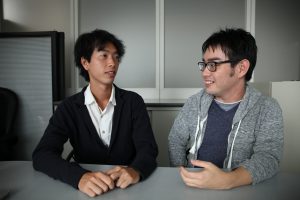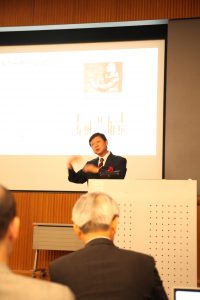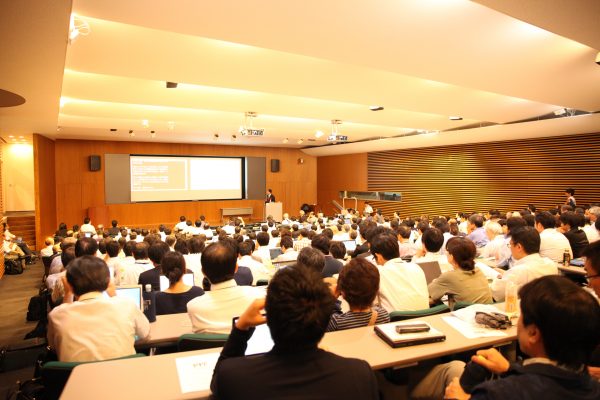
November 2, 2017
FIT 2017 @本郷キャンパス 参加報告FIT2017: Forum on Information Technology at Hongo campus
平成29年9月12日から14日まで、東京大学本郷キャンパスでFIT2017(第16回情報科学技術フォーラム)が開かれました。FITは、情報処理学会と電子情報通信学会の情報・システムソサイエティおよびヒューマンコミュニケーショングループとが合同で年に一度開催する、情報系の大規模イベントです。
学際情報学府からは、相澤研究室修士課程二年の安沢昌志さんと石見和也さんの研究発表がありました。安沢さんは、食事画像の認識精度の向上に取り組んでいます。食事画像は人によってクラスの定義や粒度が違う独特の難しさがあるため、プリセットの学習画像だけでなく、他ユーザやその人自身が逐次的に追加した画像により学習器を個人適応させる工夫がユーザビリティ向上のために必要だそうです。機械が知らない画像でも一度見るだけで次からは認識できるような、賢い機能の実現に向けた内容でした。また食事画像のメディアやSNSでの出現から食事のトレンドを予測するような内容にも取り組んでいるそうです。
石見和也さんは、三次元復元の精度向上を実現していました。ここでいう三次元復元とは、車載カメラのビデオといった時系列画像から周辺の剛体(たとえば建物など)の形状とカメラの位置と姿勢を同時に復元することです。このような場合、特に単眼のカメラを使い大規模な復元を行う場合、時間が経過するごとに誤差が累積し、全体として形状が大きくずれてしまう問題があります。石見さんは、Google street viewなどのジオタグ付きの画像を参照することで、数十メートルあった誤差を数メートルの精度まで向上させました。今後は、現在は後処理として行っている補正を、形状とカメラ位置の復元のアルゴリズムの中に組み込む予定だそうです。
また今年度は、池内克史名誉教授が船井業績賞を受賞され、その記念講演がありました。池内名誉教授は、学環に馴染み深い方のお一人で、学環設立時から一昨年まで学環に所属されていました。文化財のデジタル保存、高度交通システム、ロボティクスといった情報学や機械工学の研究テーマを通じて、考古学、建築学、民俗学、交通工学といった異なる分野との連携による新規研究分野の開拓にご尽力され、また多くの研究者、企業の指導者を輩出してこられました。講演は人工知能の趨勢を俯瞰しながら池内先生のご研究、特に、ビンピッキングロボットに始まり踊りロボットに至る、人まねロボットのご研究を振り返る内容で、知的とは何か、ロボットに魂を宿すには、といった議論もなされていました。
記事:川上玲(助教)
FIT2017 was held at Hongo campus from 12th to 14th, September, this year. FIT is a large annual forum held jointly by the IPSJ (Information Processing Society of Japan) and the System Society and Human Communication Group of the IEICE (the Institute of Electronics, Information and Communication Engineers).
Two second-year Master’s students, Masashi Anzawa and Kazuya Iwami, from Aizawa laboratory presented their studies. Masashi is seeking ways to improve the accuracy of image recognition for food items. Food is difficult for image recognition because the definition and granularity of food categories vary among people; therefore, he is attempting to personalize learning devices with images sequentially added by the user and others. Masashi is trying to realize a wise function that recognizes things at a glance. He also likes to predict eating trends by identifying food images in the mass media and SNS.
Kazuya presented a study about improving the reconstruction of three-dimensional bodies (such as buildings) from the temporal sequence of images taken by a moving video camera. Particularly when using a monocular camera for a large-scale reconstruction, error accumulation often leads to serious displacement. To solve this, Kazuya utilized geo-tagged images (e.g., google street views) as ground-truth references, thus reducing the average error by a factor of ten. Although this correction is currently being done through post-processing, there are plans to incorporate the process into the algorithm itself.
Katsushi Ikeuchi, an emeritus professor, received the Funai Achievement Award, and gave a commemorative talk. He was at the III from its establishment until his retirement two years ago. Through his research on informatics and mechanics, including digital archiving, intelligent transport systems, and robotics, he has collaborated with many researchers in different fields such as archeology, architecture, folkloristics and traffic engineering. He has thus pioneered new research fields, and supervised many researchers and corporate leaders. His talk was mainly about learning-from-observation robots, ranging from bin-picking robots to dancing robots, with respect to the history of artificial intelligence. He also raised questions about the very definition of intelligence and how to imbue robots with souls.
Text and Photo: Rei Kawakami (Assistant professor)
Proofreading: David Buist (Project senior specialist)

